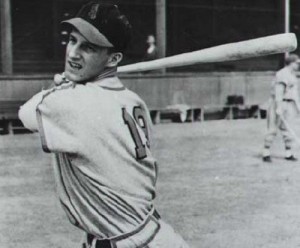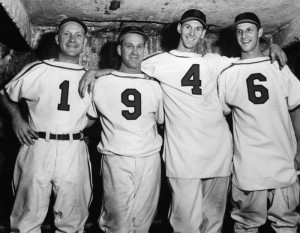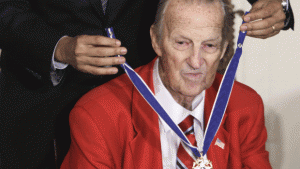70 Years Ago: Stan “The Man” Musial Begins His Remarkable Career

Stan Musial was 20-years-old when he made his debut for the St. Louis Cardinals on September 17, 1941.
It was 70 years ago today that one of the magical careers in Major League baseball history had its genesis during the second game of a doubleheader between the Boston Braves and St. Louis Cardinals. A rail-thin 20-year-old left-handed hitter named Stan Musial gave a hint of what was to come by two hits, including a double, and driving home two runs in a 3-2 Cardinals victory.
In hindsight, it is fitting that one of the greatest players in baseball history made his debut during the magical 1941 season.
In the months before Pearl Harbor and America’s entrance into World War II, the country was fixated on baseball and captivated by a pair of stars who were doing magical things with a bat.
Joe DiMaggio of the New York Yankees parlayed a record 56-game hitting streak into the MVP season. Ted Williams “The Splendid Splinter” ran away with baseball’s batting crown with a .406 average. No one could have predicted that 70 years later both records would remain unmatched across the annals of baseball.
Musial’s major league debut came barely a year after it was feared his career might be over before it started. Originally signed from his hometown of Denora, Pennsylvania as a pitcher and outfielder, Musial was playing for Daytona in the Florida State League when he jammed his left shoulder diving for a ball and was no longer able to pitch. However, little more than a year later he was thrust into a playoff race as a late-season call-up of the Cardinals.
When Musial made his debut, the Cardinals were on their way to an impressive 97-56 record, but were a game behind the first place Brooklyn Dodgers. They went 7-5 in the final 12 games, with Musial playing in all 12, and ended the season 2.5 games behind the Dodgers and their 100-54 record.
But it certainly wasn’t Musial’s fault that the Cardinals couldn’t catch the Dodgers. The young outfielder showed glimpses of what was to come over the next 20+ years by hitting .426 with four doubles, a home run and seven RBI in 12 games.
As a rookie in 1942, Musial proved that his audition in 1941 had not been a fluke as he hit .315 with 72 RBI and 32 doubles as the Cardinals won the pennant and the World Series.
He won the first of his seven batting titles in 1943 and was named the NL MVP for the first time as the Cardinals again reached the World Series (they lost in five games to the Yankees).
After leading the Cardinals to another World Series title in 1944, Musial missed the entire 1945 season due to military service.

The Cardinals won their third World Series in a five year stretch in 1946. Included in the photo are Whitey Kurowki (#1), Enos Slaughter (#9), Marty Marion (#4) and Musial.
Returning anew in 1946 at the age of 25, Musial’s power numbers started to increase. He drove home 103 runs while blasting 50 doubles, 20 triples, a then career-high 16 home runs and hitting .365 to win his second MVP Award. The Cardinals also claimed their third World Series title in five years.
While Musial was just coming into his own as an offensive superstar, that would prove to be the high-water mark for the Cardinals as a team during his career. The Cardinals didn’t reach another World Series until the year after Musial retired.
For that reason, while he was establishing himself as the top offensive player in the National League, he didn’t always receive as much attention as many of the stars from the East Coast.
In 1948 Musial established career highs with a .376 batting average, 39 home runs and 131 RBI to narrowly miss the triple crown (he finished third in home runs). His career year resulted in his third MVP Award in five seasons.
Musial finished second in the MVP voting three straight years from 1949-51 and again in 1957, but never again claimed the award.
Throughout the 1950s, Musial was among baseball’s most consistent players. He hit better than .300 every season of his career until an uncharacteristic .255 average in 1959 (at the age of 38) and drove home 100 or more runs 10 times between 1946 and 1957.
In 1962, the 41-year-old Musial finished 10th in the NL MVP voting while hitting .330 with 19 home runs and 82 RBI. He retired the following season after being named an All-Star for the 20th straight season.
Musial finished his career with a .331 batting average and a then NL record 3,630 hits. He also blasted 475 home runs, 725 doubles (still third all-time) and drove home 1,951 runs (sixth all-time).
In the five decades since his retirement, there have been many great baseball players, but few who displayed the consistency and the enthusiasm of Musial. Even though he didn’t receive the same level of attention and notoriety as Williams and DiMaggio early in his career and then later that of players like Mickey Mantle, Jackie Robinson and Willie Mays, the fact that Musial crossed generations has helped his greatness endure well past his retirement.
Though the now 90-year-old Musial no longer regularly attends the Baseball Hall of Fame induction ceremony, for many years he treated fans with his special harmonica rendition of “Take Me Out To the Ball Game.”
He has often been celebrated by fans in St. Louis, including at the 2009 All-Star Game held at the new Busch Stadium. In 2011, he received the highest civilian honor in the United States as a recipient of the Medal of Freedom.
Though Sportsman’s Park, where Musial began his legendary career 70 years ago, is long gone, the memories of his greatness will never be forgotten.










